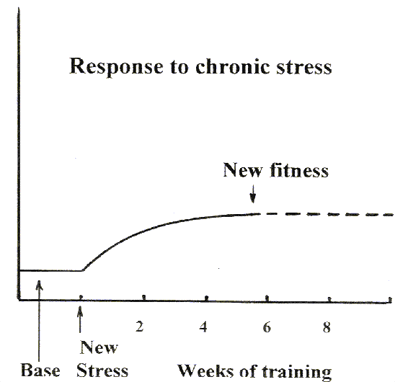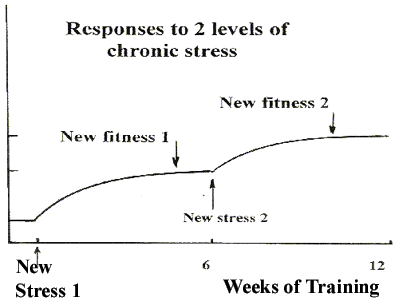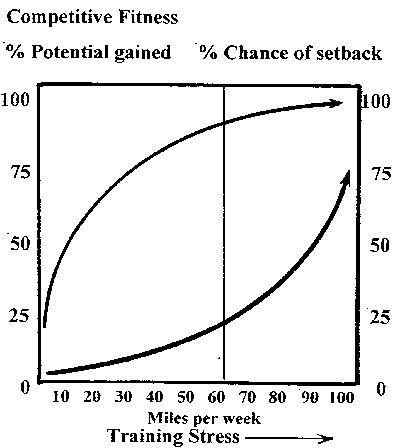|
Running Training: Principles and Needs
Article By: Jack Daniels
Training principle #1 -- the body reacts to stress. There are two types of reaction to the stress of
exercise: 1) An acute reaction, such as you would experience if you got up from your seat, went outside and ran
to the comer. Heart rate speeds up, stroke volume (the amount of blood pumped with each beat of the heart) increases,
ventilation rate and depth of breathing increase, blood pressure rises, your muscles feel some fatigue, etc. If
you perform this ritual--running to the comer-on a regular basis, then you will continue to get regular, acute
reactions to this activity. You will also get a different reaction to the repeated, chronic exercise, or training,
as we favor calling it.
(2) Training produces changes throughout your body , which allow you to perform the daily run-to-the-comer with
less discomfort (and probably in less time as well). The muscles that are stressed become stronger and blood flow
to the exercising muscles becomes more generous. Changes inside the muscle cells provide more energy for the muscles,
and less lactic acid accumulates during the bout of exercise. Your resting heart rate will undoubtedly be slower
(due to a stronger heart being able to pump more blood per beat and, therefore, needing fewer beats to deliver
the needed blood). Also, yo&ll probably develop a lighter, springier step (due to fitter leg muscles), lower
resting blood pressure, lower body weight, and less fat under the skin.
Training principle #2 - Specificity of training. The system which is stressed is the one which stands to
benefit from the stress. While training for one particular sport usually has little or no beneficial effect on
your ability to perform a second sport, in some cases there may actually be a detrimental effect. An example of
this would be the negative effect that long-distance running has on explosive leg activities, such as sprinting
and jumping. The same thing could be said for what body building would do for distance running; the extra muscle
mass developed can act as dead weight, interfering with a runner's ability to optimize his or her distance-running
capabilities.
To become really accomplished at something, you must practice doing that thing, not some other activity, which
may not only take time away from the activity of primary interest, but may also actually produce results which
limit performance in the main sport. This is not to say that all non-specific activity is bad, but considerable
thought must be given to every aspect of running, and you must know what everything you do is doing for (or to)
you.
Training principle 3 -- Specificity of over training Just as training benefits those body systems which
are properly stressed by the exercise, overstrained has a negative impact on the systems which are over-stressed.
Naturally, it is possible for a single, over stressed system to affect a variety of activities other than the one
which caused the damage. For example, a stress fracture in the leg, brought about by too much, or improper, running,
can prevent a runner from performing other activities which also put stress on the injured extremity. However,too
much running doesn't always mean
you become over trained in other types of physical activity, and it may be beneficial to limit running for periods
of time in favor of other types of training.
Training principle #4 -- A specific stress produces a specific result This is common sense, but still important
to bear in mind. This principle really says that the benefits that can be expected from doing 3 1-mile run at 8-minutes
each, with 5-minutes recovery between runs, 3 days a week, are specific to that frequency (3 times each week),
amount or load (3 miles of running per
session), intensity (8:00 pace), and recovery between runs (5-minutes). Someone who carries out this training regimen
regularly, will reach a level of running proficiency which will remain stable (and which will be different from
the proficiency level reached if the training program consisted of
five-mile runs at a speed of 7:00 per mile pace. Figure 1 shows how a new level of fitness would be reached over
time.
Figure 1

At that point, the possibilities for training modifications are limitless. You could increase the training frequency,
from 3 to 4 or more days per week; increase the amount of training, from 3 to 4 miles per session or by increasing
each of the 3 individual workouts from 1 mile to 1-1/2 miles each. Another possibility would be to increase the
intensity (speed of running each mile), from 8-minute pace to 7:40 pace, for example. A final possibility would
be to change the
recovery time allowed between the mile runs within a workout. Any one of these changes in training (frequency,
duration, intensity, or recovery) or any of these changes in combination with one another, will affect the result
of the program, resulting in a new level of fitness being reached over time.
(see Figure 2).
Figure 2

Training principle #5 -- Rate-of-achievement principle This principle is depicted by the curves in both
Figures 1 and 2. You will notice that the rate of achieving the ultimate benefits of a particular type of
training program 4 is rapid at first and then tapers off over time. A look at the time scales on these curves shows
that most of the benefits of a particular training regimen are quite adequately realized in a matter of four to
six weeks. Keep in mind, that sticking with a training program for longer than six weeks may continue to produce
more benefits, because without an increased stress of training there might be continued changes in body composition
(loss of unnecessary fat, for example), which can produce better performance. However, quite
adequate benefits are realized in a matter of weeks.
If the runner described in Figure 1 wanted to increase training, a good time would be after about six weeks,
and Figure 2 shows how the reaction to such changes would look if the alterations were imposed at six-week
intervals. The danger of changing (increasing) training too often, is primarily increased risk of injury, or over
stress caused by taking on too much too fast. Remember, it is very difficult to get a feeling of what a particular
training load is doing for you if
you do it stay with it for awhile.
Training principle #6 -- Personal limits Another principle of training, which is related to the curves I
have been presenting, is that each individual has unique personal limits. In fact, you could probably safely say
that every system in a person's body has limits. For example, there is a limit as to how to you will be, how strong
a particular muscle in your body can get (the heart
muscle being an important one for all of us), how much air you can breathe in and out of your lungs, how much blood
cm be transported to your running muscles, how much oxygen your running muscles can use in converting fuel to energy,
and how fast you can run a mile, a 10K or a marathon. It may be sad, but we all have limits, and these limits can
vary greatly from individual to individual. Different ones of us will reach different degrees of success, which
are greatly dictated by what our limits are. The good news is that probably few people realize their limits, relative
to running, and improvement is almost always possible. Further, the limit often is seasonal and next year things
will continue to improve, to a new "limit".
Training principle #7 -- Diminishing return The upper (left) curve of Figure 3 uses mileage to clarify
this principle. The benefits of 'increasing weekly mileage are shown in this figure, with an all-inclusive term,
"competitive fitness," plotted against weekly mileage. Take the example of someone who starts training
with 10 miles per week, then doubles it to 20, then again doubles to 40 and finally to 80 miles per week, allowing
a couple months at each level It doesn't matter how gradually this runner progresses from 20 to 40 to 80 weekly
miles of training. The point is that the benefits reaped from 40 miles per week are not double those realized as
a result of 20-mile weeks. Nor are the results of 80 double that of 40 or 4 times the benefit of 20 miles per week.
Adding more and more mileage to your weekly training does not produce equal percentages of improvement in competitive
fitness. The same thing applies to increasing the amount of faster, quality training.
Figure 3

Training principle #8 -- Accelerating setbacks The nature of the curve that depicts this principle is the
mirror image of the diminishing-returns curve and is shown in lower (right) curve of Figure 3. Here, increases
in training stress are plotted against the chance of encountering a setback, which might take the form of an injury
or illness or even a lack of interest in training. A setback is a setback and all must usually be avoided at all
costs. The setback principle simply states that low levels of training produce few setbacks, and as a person trains
harder and harder, the potential for setbacks increases exponentially.
Training principle #9 -- Ease of maintenance This principle holds particularly true for maintenance of a
level of competitive ability, which must at least in part be a function of reaching a particular level of confidence.
Although I am primarily referring to physiological fitness, it is no secret that psychological factors play an
important part in how fast you can race. Once you break the 5-minute mile barrier, or any other personal goal doing
it again is not the task it was the first time, and the effort required (in training) to repeat the task is usually
well short of what was initially involved.
The maintenance principle is an important one to consider when planning a long-term train@ program because it allows
you to shift your training emphasis from one system (say development of cellular adaptations that respond favorably
to long, easy mileage) to another system (repetition work for the enhancement of economy, for example), and yet
still maintain the cellular benefits through less-frequent attention to the longer runs.
Training principle # 10 -- Time-erodes-memory You always tend to forget how hard you trained earlier in
your career, when you are disappointed by how hard it is to make a comeback. This is the "time-erodes-memory"
principle.
Part 2: Aerobic Profile: Continue Here
International Copyright © of CoachesEducation.com. All Rights Reserved.
Reproduction in whole or in part in any form or medium without
express written permission
of CoachesEducation.com is strictly prohibited.
|
|
![]()




